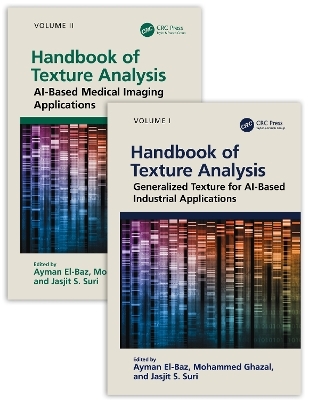
Handbook of Texture Analysis, Two-Volume Set
CRC Press
978-0-367-48341-8 (ISBN)
- Titel z.Zt. nicht lieferbar
- Versandkostenfrei innerhalb Deutschlands
- Auch auf Rechnung
- Verfügbarkeit in der Filiale vor Ort prüfen
- Artikel merken
Ayman El-Baz is a Distinguished Professor at University of Louisville, Kentucky, United States and University of Louisville at Alamein International University (UofL-AIU), New Alamein City, Egypt. Dr. El-Baz earned his B.Sc. and M.Sc. degrees in electrical engineering in 1997 and 2001, respectively. He earned his Ph.D. in electrical engineering from the University of Louisville in 2006. Dr. El-Baz was named as a Fellow for IEEE, Coulter, AIMBE and NAI for his contributions to the field of biomedical translational research. Dr. El-Baz has almost two decades of hands-on experience in the fields of bio-imaging modeling and non-invasive computer-assisted diagnosis systems. He has authored or coauthored more than 700 technical articles. Mohammed Ghazal is a Professor and Chairman of the Department of Electrical, Computer, and Biomedical Engineering at the College of Engineering, Abu Dhabi University, UAE. His research areas are bioengineering, image and video processing, and smart systems. He received his Ph.D and M.A.Sc in Electrical and Computer Engineering (ECE) from Concordia University in Montreal Canada in 2010 and 2006, respectively, and his B.Sc. in Computer Engineering from the American University of Sharjah (AUS) in 2004. He has received multiple awards including the Distinguished Faculty Award of Abu Dhabi University in 2017 and 2014. Dr. Ghazal has authored or co-authored over 70 publications in recognized international journals and conferences including IEEE Transactions in Image Processing, IEEE Transactions in Circuits and Systems for Video Technology, IEEE Transactions in Consumer Electronics, Elsevier's Renewable Energy Reviews, and Springer's Multimedia Tools and Applications. Jasjit S. Suri is an innovator, scientist, visionary, industrialist and an internationally known world leader in biomedical engineering. Dr. Suri has spent over 25 years in the field of biomedical engineering/devices and its management. He received his Ph.D. from the University of Washington, Seattle and his Business Management Sciences degree from Weatherhead, Case Western Reserve University, Cleveland, Ohio. Dr. Suri was crowned with President’s Gold medal in 1980 and made Fellow of the American Institute of Medical and Biological Engineering for his outstanding contributions. In 2018, he was awarded the Marquis Life Time Achievement Award for his outstanding contributions and dedication to medical imaging and its management.
Handbook of Texture Analysis: Generalized Texture for AI-Based Industrial Applications (Volume 1)
Part A: Texture Segmentation. 1. Texture-Based Segmentation for Extracting Image Shape Features. 2. Modeling and Segmentation of Noisy and Textured Images Using Gibbs Random Fields. 3. A Spatially Constrained Color-Texture Model for Image Segmentation. 4. Texture Segmentation Using Gabor Filters. Part B: Texture Classification. 5. Textural Features for Image Classification. 6. A Statistical Approach to Texture Classification. 7. Texture Classification From Random Features. 8. Texture Classification and Its Applications. 9. Texture Classification of Magnetic Resonance Images of the Human Brain. Part C: Shape From Texture. 10. Shape From Texture Without Boundaries. 11. General Principles for Shape From Texture. 12. 3D Shape From Texture. 13. The Equations for Recovering Shape From Texture. Part D: Texture Modeling. 14. Complex Building Description and Extraction Based on Hough Transformation and Cycle Detection. 15. Image Quilting for Texture Synthesis and Transfer. 16. Texture Analysis Using Gray Level Run Lengths. 17. The Use of Markov Random Fields as Models of Textures.
Handbook of Texture Analysis: AI-Based Medical Imaging Applications (Volume 2)
Part A: Texture in Medical Imaging. 1. Texture Analysis: A Review of Neurologic MR Imaging Applications.2. A Survey of Preprocessing and Feature Extraction Techniques for Radiographic Images. 3. CNN for Texture and Dynamic Texture Analysis. 4. Deep Learning in Texture Analysis and Its Application. Part B: Texture Synthesis. 5. Image Quilting for Texture Synthesis and Transfer. 6. Texture Synthesis Using Gray Level Run Lengths. 7. Gabor Filters as Texture Discriminator. 8. Hough Transformation and Texture Synthesis. 9. The Use of Markov Random Fields as Models of Textures. Part C: Texture Analysis and Its Applications. 11. Complex Building Description and Extraction Based on Hough Transformation and Cycle Detection. 12. Journey Toward Computer-Aided Diagnosis: Role of Image Texture Analysis. 13. A Review on Texture Analysis Methods in Biomedical Image Processing. 14. Image Filtering Techniques for Medical Image Post-Processing: An Overview. 15. Statistical Models of Appearance for Medical Image Analysis and Computer Vision. 16. Appearance Analysis for Diagnosing Malignant Lung Nodules. 17. Big Data, Decision Tree Induction, and Texture.
| Erscheint lt. Verlag | 24.6.2024 |
|---|---|
| Zusatzinfo | 60 Tables, black and white; 35 Line drawings, black and white; 39 Halftones, black and white; 87 Illustrations, black and white |
| Verlagsort | London |
| Sprache | englisch |
| Maße | 156 x 234 mm |
| Gewicht | 1120 g |
| Themenwelt | Informatik ► Grafik / Design ► Digitale Bildverarbeitung |
| Informatik ► Theorie / Studium ► Künstliche Intelligenz / Robotik | |
| Medizin / Pharmazie ► Physiotherapie / Ergotherapie ► Orthopädie | |
| Technik ► Elektrotechnik / Energietechnik | |
| Technik ► Medizintechnik | |
| Technik ► Umwelttechnik / Biotechnologie | |
| ISBN-10 | 0-367-48341-6 / 0367483416 |
| ISBN-13 | 978-0-367-48341-8 / 9780367483418 |
| Zustand | Neuware |
| Haben Sie eine Frage zum Produkt? |